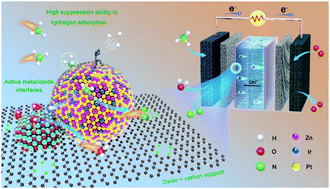High-performance ammonia oxidation catalysts for anion-exchange membrane direct ammonia fuel cells†
Abstract
Low-temperature direct ammonia fuel cells (DAFCs) use carbon-neutral ammonia as a fuel, which has attracted increasing attention recently due to ammonia's low source-to-tank energy cost, easy transport and storage, and wide availability. However, current DAFC technologies are greatly limited by the kinetically sluggish ammonia oxidation reaction (AOR) at the anode. Herein, we report an AOR catalyst, in which ternary PtIrZn nanoparticles with an average size of 2.3 ± 0.2 nm were highly dispersed on a binary composite support comprising cerium oxide (CeO2) and zeolitic imidazolate framework-8 (ZIF-8)-derived carbon (PtIrZn/CeO2-ZIF-8) through a sonochemical-assisted synthesis method. The PtIrZn alloy, with the aid of abundant OHad provided by CeO2 and uniform particle dispersibility contributed by porous ZIF-8 carbon (surface area: ∼600 m2 g−1), has shown highly efficient catalytic activity for the AOR in alkaline media, superior to that of commercial PtIr/C. The rotating disk electrode (RDE) results indicate a lower onset potential (0.35 vs. 0.43 V), relative to the reversible hydrogen electrode at room temperature, and a decreased activation energy (∼36.7 vs. 50.8 kJ mol−1) relative to the PtIr/C catalyst. Notably, the PtIrZn/CeO2-ZIF-8 catalyst was assembled with a high-performance hydroxide anion-exchange membrane to fabricate an alkaline DAFC, reaching a peak power density of 91 mW cm−2. Unlike in aqueous electrolytes, supports play a critical role in improving uniform ionomer distribution and mass transport in the anode. PtIrZn nanoparticles on silicon dioxide (SiO2) integrated with carboxyl-functionalized carbon nanotubes (CNT–COOH) were further studied as the anode in a DAFC. A significantly enhanced peak power density of 314 mW cm−2 was achieved. Density functional theory calculations elucidated that Zn atoms in the PtIr alloy can reduce the theoretical limiting potential of *NH2 dehydrogenation to *NH by ∼0.1 V, which can be attributed to a Zn-modulated upshift of the Pt–Ir d-band that facilitates the N–H bond breakage.

- This article is part of the themed collection: Energy & Environmental Science Recent HOT Articles


 Please wait while we load your content...
Please wait while we load your content...
